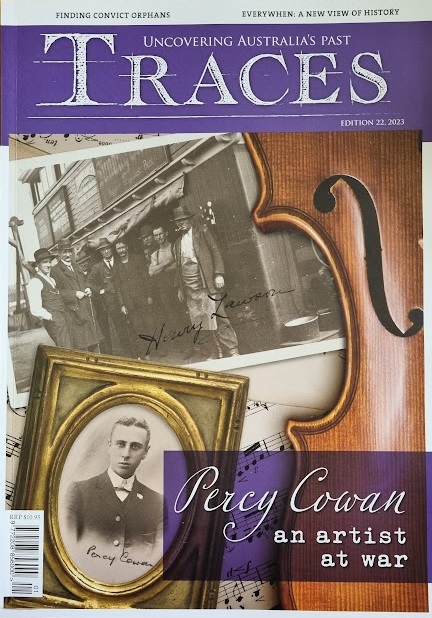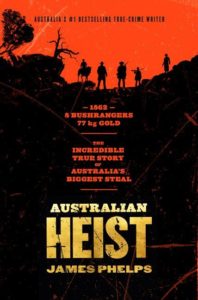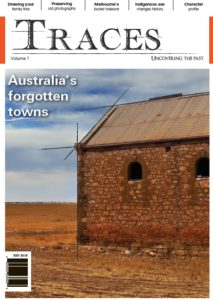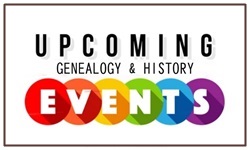Traces Magazine – Issue 22 (April 2023)
If you have a love of Australian history and genealogy, this is just what you need. As with all every issue of Traces, this one is packed with high quality Australian history and genealogy-related articles.
Issue 22 recently hit the newsagent shelves, (or your letterbox if you’re a subscriber), so what great articles are in this issue?

In this edition Traces welcomes back some regular writers, and several new contributors.
Karoline Cernoch explores the stunning Waverley Cemetery, and the social and cultural factors that led to its development.
Dr David Waldron shares the grizzly story of Fitzroy’s Hand of Glory, and the folklore maintained by Melbourne’s 19th-century immigrants.
The genealogy section features a fascinating article by Lucy Frost about convict orphans, transported from Australia with their convict mothers, and how to find them in your family tree.
While the cover story, written by Peter Baker, charts the rise and tragic fall of violinist and entertainer Percy Cowan, his wartime service and his enduring friendship with poet Henry Lawson.
There’s another “Vintage Vernacular” article, and a profile of the grand historical estate Edina, with its Scottish connections. But there’s plenty more to discover in this edition’s pages, so if you love Australian history and/or genealogy, do yourself a favour, and grab a copy of Traces.
Available in both printed and digital form, you can subscribe through iSubscribe or Traces magazine directly. You can buy the current issue from some newsagents, and back issues of the magazine from Traces magazine themselves.
More information:
Website: http://tracesmagazine.com.au/
Follow along:
Facebook: https://www.facebook.com/TracesMag/
Twitter: https://twitter.com/traces_mag
Instagram: https://www.instagram.com/tracesmag/
“The Forensic Genealogist” – I’m a Fan
I’ve never been one to follow the latest trend. Instead I tend to come to the party late … if at all.
So it is with the latest additions to my book collection. I do love a good read. A good novel to tune out with, and I have a number of authors that I have read all their books cover to cover. And now I have a new name to that list, and that is Nathan Dylan Goodwin.
I know many of you have heard of him already, and are longtime dedicated fans … like I said, I don’t follow the crowd, but I usually get there eventually.
Anyway for the benefit of of the odd person who doesn’t know of him, Nathan writes fiction books with Morton Farrier as the lead character who is a forensic genealogist – yes, truly! Cool, eh?
He’s written 8 books in “The Forensic Genealogist” series to date, and I’m currently partway through them, but with some long plane flights coming up, I expect to get through another one or two.
I’m not going to tell you anything about the books, except that if you love a good read, lots of suspense, along with action, and genealogy – you’ll get it all (at least in those I’ve read so far). And you’ll get taken into Morton’s world of life as a researcher and see how he susses out his cases, visiting many archives and other places along the way.
The titles in this series (to date are):
- Hiding the Past
- The Lost Ancestor
- The Orange Lilies
- The America Ground
- The Spyglass File
- The Missing Man
- The Wicked Trade & The Suffragette’s Secret
- The Sterling Affair
Nathan even has a prequel to the series on his website, which you can download for free.
The Forensic Genealogist series are available in book form and as ebooks, so do yourself a favour if you like a good read, and check out NATHAN DYLAN GOODWIN’S books.
www.nathandylangoodwin.com
Australia’s Biggest Ever Gold Robbery
1862.
8 Bushrangers.
77kg of Gold!
The incredible true story of Australia’s Biggest Steal.
Did that get your attention? It sure got mine.
‘Australian Heist‘ is the title of a brand new book written by James Phelps, who is quoted as being Australia’s #1 bestselling true-crime writer. I’ll admit it’s not a name I was familiar with, but I sure am now!!
Written as well as any good fiction book, it really is a non-stop-page-turner, with fascinating characters, and twists all the way through. And yet this is Australian history. It really happened. And it happened in what was our ancestors era.
 This isn’t an official book review, and I’m not going to spoil the book for you, but I will give you the speil …
This isn’t an official book review, and I’m not going to spoil the book for you, but I will give you the speil …
On 15 June 1862, a gang of bushrangers held up a gold escort at Eugowra, just east of Forbes in new South Wales. They escaped with a pile of cash and 77 kilograms of gold, worth about $10 million today.
It remains the largest gold robbery in Australian history.
In this riveting re-creation of the events, James Phelps finally tells the full story of how Frank Gardiner, Ben Hall, John O’Meally, Johnny Gilbert, Henry Manns, Alexander Fordyce, John Bow and Dan Charters planned and executed the robbery – and what happened to all that gold. And the map!
‘Australian Heist’ is a thrilling, fast-paced and thoroughly modern take on one of the most extraordinary episodes in the nation’s history.
Anyway here’s all the relevant book details for you:
Title: Australian Heist
Author: James Phelps
Format: hardcover
Pages: 368 pages
Published: 2018
ISBN: 9781460756232
Publisher: HarperCollins Australia
Buy the printed book
Buy the ebook
To give you full disclosure. Yes, I do work in a genealogy bookstore, and this is a book that we do sell. But I bought my own copy as it sounded fascinating. No, I’m not trying to sell you anything, but rather just informing you of a book that is a really awesome read. Ok, disclosure done.
So if you love fast paced-action books, and you get a chance to read ‘Australian Heist‘, I guarantee you’ll totally love it!
Love Australian History? Get “Traces”
If you love Australian history and/or genealogy, let me introduce you to “Traces“. Traces is a brand spanking new Australian genealogy and history magazine.
It is exciting to have a new magazine available, because we’ve seen far too many disappear over the past few years, which no doubt is a sign of the times. Anyway call me old fashioned, but I’m a physical paper magazine lover, and I still get excited when a new issue arrives in the mail.
As for what it’s about, the magazine states that …
“Traces magazine is for anyone interested in this country’s history, from ancient Indigenous heritage to European settlement, local history, artefacts and family genealogy.
Launched in December 2017, Traces is the only quarterly printed magazine dedicated to providing its readers with insight into the latest historical research, news, events and heritage projects taking place around Australia. The expert voices of historians, researchers, heritage professionals, genealogists and journalists uncover the fascinating characters and stories of our past.”
Anyway Issue 1 (or Volume 1 as they actually call it) of Traces magazine is an awesome read. As with most of the genie mags I get, I’ve read it from cover to cover. Basically you’ll find 64 pages of interesting, well-written articles.
Some of the topics covered in Issue 1 are …
– Getting started on your family tree
– the wrecking of the ‘Batavia’
– Indigenous convicts
– the Brennan & Geraghty’s Store Museum which really is ‘a store that time forgot’
– discover the history of Silverton, New South Wales
– Caring for your precious textiles
– learn how to date old photos through fashion
– read all about ‘the masher’
– info on the Historic Houses Association of Australia
– discover the wealth of history that is housed in the Prahran Mechanics Institute
Issue 1 hit the newsagents (and letterboxes) in December just before Christmas, and as it is a quarterly magazine, I assume we’ll see Issue 2 arrive sometime in March 2018.
The price of AUD$9.95 per issue is certainly well worth the cost, and of course it is cheaper if you take out a subscription anyway.
For anyone who loved Inside History Magazine, you will love Traces just as much!
For more information, to subscribe, or buy a copy of Traces (if your local newsagent doesn’t stock them) be sure to check out: https://www.tracesmagazine.com.au/, and follow them on Facebook to keep up with the latest Australian history-related news.





